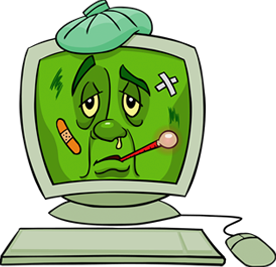We can spend hundreds of dollars and countless amounts of hours purchasing and setting up anti-virus software in hope of never having to deal with the horrors that come with a computer virus. But, what happens when we actually get one? What do we do? Are there certain procedures that should be followed?
A virus can attack your computer without you knowing. With all the downloading and installing we are doing know-a-days, we are more prone than ever to catching one of these computer diseases. So it pays to know exactly what we should do and how we should deal with this situation.
1. Disconnect
Chances are that if you’ve caught a virus, you’ve probably caught it from somewhere internet. Therefore, disconnecting you PC from the internet is the first thing you should do as soon as you feel you may have a virus. Disconnecting your PC not only stops your PC from getting more viruses, but also can stop the virus from spreading onto other computers that are connected to the ‘home network’.
2. Scan
The next step should be to scan your computer with the anti-virus software you should already have installed. Running a full system scan is your best bet in finding the virus, and once the scan identifies the virus be sure to choose the option to remove and clean out the predator.
After the anti-virus software has removed the virus, reboot the PC and run another scan just to be safe. You want to be 100% sure you have removed the virus before doing any online shopping or sending any emails to your friends and family.
If your anti-virus software has not identified the unwanted visitor, it would probably pay to run anti-malware and anti-spyware software. Or, if you know the type of virus or even where it came from, try searching the internet (from an uninfected device) for more specific directions on how to successfully remove it from your PC.
3. Re-install
Hopefully, prior to having caught the virus, you had backups of your files and programs. Viruses are known to remove and uninstall files and programs from your PC, so you’re probably going to have to access your back-up files and install them all over again. This can be a time consuming task. You are probably going to have to go through your computer and find what has and what hasn’t been removed to find what needs to be re-installed.
4. Back-Up
Having experienced the dread of dealing with a virus attack, you will understand the importance of backing up all your data. This relieves a bit of the stress that comes with a virus attack. There are a number of ways in which you can back up your data such as using removable devices such as hard drives, CDs, or USBs or using the cloud storage.
5. Prevent Future Attacks
Having been attacked probably suggests that you need to up the ante on your computers security. Doing this may involve having to constantly check that your security system is up-to-date. Some software however, allow you to set an automatic update scan to ensure that it is always up to date.
You may also want to change anti-virus software. If it wasn’t able to detect and protect your computer from the last virus, chances are it won’t do it again. There are many free and paid-for software that do a great job of PC security and protection, a simple Google search can show you which ones users are recommending and which ones are the best option for you.
We Want to Hear From You
Send us an email at enquiries@advancedcomputers.co.nz or post onto our Facebook Page and share your experiences with Virus attacks. Do you have any advice on how to prevent or remove a PC virus?
Also, if you need any help fighting a computer virus or feel you want need more help, feel free to call us today on (09) 526-1800 or send us an email at enquiries@advancedcomputers.co.nz and we can discuss the matter to ensure you stay safe.
Win an iPad Mini!
Don’t forget to enter the draw to win a 16GB Apple iPad Mini. Registration takes 30 seconds, all you have to do is visit our Facebook Page or follow this link: http://a.pgtb.me/Q2G5b9



